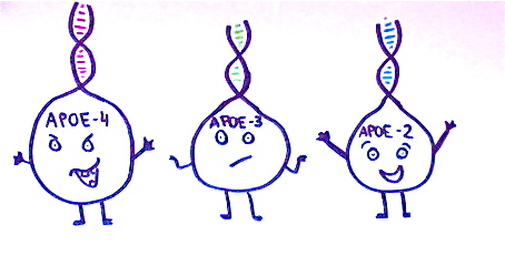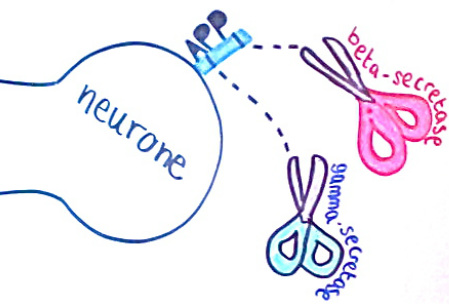There are also aspects of mental wellbeing which are thought to influence the development of Alzheimer’s. These include stress, mental activity and head trauma.
 Stress is being investigated as a possible risk factor. In stressful events large amounts of hormones are produced, such as adrenaline and cortisol. The hippocampus is the main area of the brain where cortisol and other steroid hormones interact. (As mentioned earlier in “A Tale of Two Cerebral Deposits”, the hippocampus is the area of the brain which undergoes the most significant amount of shrinkage during Alzheimer’s disease.) The concentration of cortisol largely determines its effect. A deficit of the hormone affects nerve development, whereas overproduction leads to death in the cells of the hippocampus. A 35 year long Swedish study investigated the effects of stress on 1500 women. The results showed that stressful events in the lives of the subjects increased their risk of dementia by 65%. Another study using mouse models showed that stress exacerbates the formation of tau tangles. The mice were put under repeated experiences of emotional stress. The results showed a significant increase in tau tangles, primarily in the hippocampus. With further research into the effects of stress, scientists hope to gain a better understanding of the mechanisms of Alzheimer’s and the extent to which stress contributes to its development.
 Alzheimer’s sufferers are widely advised to keep mentally active in order to slow their cognitive deterioration. But this advice is often challenged by Alzheimer’s research organisations. In the prevention of Alzheimer’s, the NHS website advises people to “stay mentally active, for example, by reading, writing or taking an adult education course”. However, this view is being cautioned upon by Alzheimer’s research organisations. Following the release of a study in 2009 which suggested the benefits of mental stimulation, the Alzheimer’s Society commented; “more research, where people are followed up over time, is needed to understand whether these sorts of activities can reduce the risk of dementia”. The National Institute of Health held a conference called “State-of-the-Science” wherein a panel asserted that there was “insufficient” evidence for this claim.
Although there has been little evidence to suggest that mental stimulation does have intervening effects, there have been studies to show a correlation between years of education and susceptibility. The relationship between neuropathology and education remains uncertain. However one investigation analysed 872 brains, 56% of which were from donors who had suffered from dementia. They found that increased years of education did not prevent dementia, but it did reduce the risk. However, this study also suggests that poor educational experience is associated with lower status. Low status is considered as a risk factor for cardiovascular disease.
It appears that more extensive studies need to be done into the effects of mental health on the development of Alzheimer’s disease. In comparison to the effects of cardiovascular disease and insulin, it is more difficult to determine the effects of mental health.
***
There are many environmental risk factors that contribute to the development of Alzheimer’s. Their effects can help us to understand how the disease is caused. We now have several different potential drug targets, as well as knowledge of preventative measures people can take to attempt to decrease their risk. However, these preventative measures are not proven to have any definitive effect. Therefore it stands to reason that genetics must also play a significant part.
ReferencesAhramjian, L., 2010., Independent Panel Finds Insufficient Evidence to Support Preventive Measures for Alzheimer's Disease, NIH News [online] Available at:< http://www.nih.gov/news/health/apr2010/od-28.htm> [Accessed 15 September 2012] Alzheimer’s Society, 2009. Research into impact of mental activity on memory loss [online] Available at: <http://alzheimers.org.uk/site/scripts/news_article.php?newsID=423> [Accessed 15 September 2012] Brayne, C. et al, 2010. Education, the brain and dementia: neuroprotection or compensation? Brain [online] Vol.133. Issue 8. Pp2210-2216 Available at: <http://brain.oxfordjournals.org/content/133/8/2210.long#cited-by> [Accessed 10 September 2012] LaFee, 2012. Chronic Stress Spawns Protein Aggregates Linked to Alzheimer’s [online] Available at: <http://ucsdnews.ucsd.edu/pressreleases/chronic_stress_spawns_protein_aggregates_linked_to_alzheimers/> [Accessed 10 September 2012] NHS choices, 2012. Alzheimer’s Disease – Prevention [online] Available at: <http://www.nhs.uk/Conditions/Alzheimers-disease/Pages/Prevention.aspx> [Accessed 10 September 2012] Roberts, M. 2012. Role of stress in dementia investigated, BBC News [online] Available at: < http://www.bbc.co.uk/news/health-18577326> [Accessed July 18 2012] Rose, S, 2003. The Making of Memory; From Molecules to Mind, Revised Edition, Great Britain : Vintage
Oxidative stress isn’t the only reason why your diet can affect your risk of developing Azlheimer’s. Both diet and lack of exercise are also contributing factors for insulin resistance. Insulin resistance is where the cells of the body respond less to the effects of insulin and therefore glucose uptake is reduced. It can lead to conditions such as hypertension, diabetes and cardiovascular disease; all of which increase the risk of Alzheimer’s. It is estimated that 25-30% of people over the age of 65 have insulin resistance.
 What is Insulin?
Insulin is necessary for brain cell function. It facilitates the uptake of glucose by the cells for use in respiration which creates the cell’s energy. The effects of insulin on Alzheimer’s have been investigated using a pilot study into intranasal insulin treatment. Insulin was administered to Alzheimer’s patients daily from a device which sprayed the hormone directly into the nasal passages. Over the four year period, the patients’ cognitive abilities were assessed. Interestingly, recall was improved further in patients receiving a lower dose of insulin but not so in those receiving a higher dose. The researchers emphasise that this was a very small study of only 104 subjects, and so more extensive studies will need to be carried out to understand these effects.
Interesting Links...
Link to diabetes
Insulin resistance is perhaps mainly associated with diabetes. Sufferers of diabetes have abnormally high blood sugar levels due to either an underproduction of insulin or a resistance of their body cells to the effects of insulin. They are also much more likely to develop Alzheimer’s disease. This provides further evidence from the previously mentioned APL-1 gene that diabetes and Alzheimer’s are linked.
Link to cardiovascular disease
Insulin resistance is also a risk factor for cardiovascular disease, which is one of the main environmental risk factors for Alzheimer’s. Cardiovascular disease affects the blood supply to the brain. If this blood supply is inefficient, there will be a lack of oxygen for the brain cells to carry out respiration.
Link to cholesterol levels
As previously mentioned, high levels of cholesterol are essential for the formation of amyloid plaques, as cholesterol facilitates the release of amyloid beta fragments from the c99 protein. But cholesterol can also contribute to the development of Alzheimer’s disease by its role in causing hypertension. High levels of cholesterol can lead to deposits forming in the arteries called atheromas. These narrow the lumen of the arteries and increase blood pressure. Hypertension is a risk factor for cardiovascular disease, and is also a known risk factor of Alzheimer’s disease. Statins are drugs that control cholesterol levels and are prescribed for the prevention of heart disease. Interestingly, recent experiments into mice found that use of the statins actually improved learning and memory function in mice. More research is needed before we could know if statins can be prescribed for Alzheimer’s, but this study does show evidence for the relationship between heart disease and Alzheimer’s.
The effects of Alcohol and Smoking
Other lifestyle choices are known to affect Alzheimer’s. One advised preventative measure of Alzheimer’s is to consume alcohol in moderation. Excessive alcohol consumption is known to lead to hypertension and insulin resistance. However alcohol also contains antioxidants, so it can be beneficial to drink it in controlled amounts. Smoking is also thought to contribute to Alzheimer’s disease. Although early studies suggested that smoking decreases the risk of Alzheimer’s, this has been widely discredited. Eleven of the controversial studies were found to have been conducted by researchers with connections to the tobacco industry. More current and reliable studies suggest that heavy smoking can increase a person’s susceptibility to Alzheimer’s, and that passive smoking may also have an effect.
References
Alzheimer’s Association, 2012. Inside the Brain: An interactive tour [online] Available at: < https://www.alz.org/braintour/alzheimers_changes.asp> [Accessed 18 July 2012] Alzheimer’s Society, 2010. Am I at risk of developing dementia? [online] Available at < http://www.alzheimers.org.uk/site/scripts/documents_info.php?documentID=102> [Accessed 18 July 2012] Craft, S. et al, 2012. Intranasal Insulin Therapy for Alzheimer Disease and Amnestic Mild Cognitive Impairment; A Pilot Clinical Trial. Archives of Neurology [online] Volume 69, Number 1. Available at < http://archneur.jamanetwork.com/article.aspx?articleid=1107947> [Accessed 18 July 2012] Goldacre, B. 2010.Smoking prevents Alzheimer’s? It depends who you ask. The Guardian [online] Available at: < http://www.guardian.co.uk/science/2010/mar/05/smoking-alzheimers-goldacre-bad-science> [Accessed 18 July 2012] HBO : Documentaries : The Alzheimer’s Project, 2012. The Connection between Insulin and Alzheimer’s [online video] Available at: < http://www.hbo.com/alzheimers/supplementary-the-connection-between-insulin-and-alzheimers.html> [Accessed 12 July 2012] Holehouse, M., 2012. Statins could stave off symptoms of Alzheimer's, study finds, The Telegraph [online] Available at: < http://www.telegraph.co.uk/health/elderhealth/9184705/Statins-could-stave-off-symptoms-of-Alzheimers-study-finds.html> [Accessed 15 September 2012] Orsitto, G. et al. 2012. Relation of Secondhand Smoking to Mild Cognitive Impairment in Older Inpatients Scientific World Journal [online] Available at: < http://www.ncbi.nlm.nih.gov/pmc/articles/PMC3361321/> [Accessed July 18 2012]
Environmental factors also significantly influence the development of Alzheimer’s Disease. Although genetic makeup can have a definitive effect in early-onset Alzheimer’s, its influences are more variable in the late-onset form. Many studies have been carried out to establish the extent of environmental influences on the development of Alzheimer’s. Due to the fact these factors are largely modifiable, they have attracted a great deal of interest.
 ^Click to enlarge. Diet and exercise are thought to have critical importance in the development of Alzheimer’s. To discuss the science that explains this, we can look at the theory of oxidative stress.
Oxygen free-radicals are very reactive forms of oxygen which are produced as a by-product of respiration. The free radicals react with other molecules inside the cell to oxidise them. Antioxidants are substances which stop this oxidation. Oxidative stress occurs when more oxygen free-radicals are produced than are counteracted by protective antioxidants. It is thought to be particularly prevalent in the brain, where a great deal of respiration occurs. The current theory suggests that oxidative stress contributes to cognitive decline in normal ageing, but this effect is increased in Alzheimer’s disease.
 In this way diet has a direct impact on the ageing process. Theoretically, a diet high in antioxidants should decrease the prevalence of oxidative stress and thus decrease the risk of Alzheimer’s Disease. An experiment in 2005 investigated this. Aged beagles were fed an antioxidant-enriched diet over a period of three years and their cognitive functions were tested. Beagles were selected as test subjects because of their cognitive functions can be assessed in similar ways to humans. The results showed improvements in memory and learning. In addition, the amyloid plaques became visibly reduced during the three year period, suggesting that the antioxidants actually helped to destroy the deposits.
 Regular exercise is also believed to lower the risk of developing Alzheimer’s. In 2012, experiments were carried out into the effects of exercise. Researchers controlled the level of exercise in two groups of mice. The mice were then placed in a water maze* as a test of learning and memory skills. The mice that had experienced a higher level of exercise performed better on these tests. Brain scans also showed that high levels of exercise increased levels of brain derived neurotrophic factor (BDNF). This is a protein which is produced in normal brain function, but its levels are significantly lower in Alzheimer’s patients.
In 2003, the Human Genome Project successfully completed the mapping of the entire human genome. Since then, genetic research has sky-rocketed. One of the most useful applications of genomics is comparative genome mapping, wherein we can look at the susceptibility genes for different conditions. That's incredible in itself, but what scientists are starting to do now is compare pathologies of different diseases and the genes associated with them. In Alzheimer's research, scientists have looked at illnesses such as diabetes and Downs Sydrome to study their genetic links with Alzheimer's.
 A gene has been found which suggests a link between diabetes and Alzheimer’s. People with type 2 diabetes have an increased risk of dementia. In diabetes, insulin resistance affects the metabolic processes of the body, including those of the nervous system. Researchers at The City College of New York studied the APL-1 gene in the nematode worms C.Elegans. APL-1 is an APP-related protein that seems to disrupt the insulin pathway. When scientists removed APL-1 from the worms, the worms died. Although the exact function of APP is not clear to scientists, this study suggests that it may be involved in the insulin processes of the nervous system.
-*-
Slight side track - C. Elegans worms are seriously cool.
Nobel prize winner Sydney Brenner discovered these worms in his backyard compost, and quickly realised how useful they would be as scientific models. One of their most useful features is their transparency, making them easily observable in microscopy. They're small, easily maintained and have a very simple anatomy of which scientists understand in its entirety. They exist in two sexes - male and hermaphrodite, and scientists can use these hermaphrodite worms to create millions of genetically identical models in a short space of time. Their anatomy, surprisingly, also has similarities to humans. They have an intestine, skin, muscles, reproductive organs and a nervous system. Although this nervous system consists of only 302 neurones, these neurones are very well described. They also use the same neurotransmitters as humans do (such as dopamine and acetylcholine). And even more surprisingly, scientists have actually discovered how to teach learning and memory in these worms so they can be studied for diseases like Alzheimer's. In fact, the presenilin genes (PSEN-1, PSEN-2) that were discussed in the last blog post were discovered through work done with these worms.
Yep, pretty awesome for something that could be digging around your compost right now...
-*-
Sufferers of Down’s Syndrome are also known to have an increased risk of developing Alzheimer’s. For sufferers in their 60s, the risk can be as high as 50%. They also tend to develop the disease much earlier (between 40-50 years old). Down’s Syndrome is a chromosomal condition based on the trisomy of chromosome 21; the same chromosome where the APP gene is located. Scientists reason that the presence of the third chromosome 21 causes the overproduction of APP and therefore increases the formation of amyloid beta plaques.
It's clear that genes do play some role in the development of Alzheimer's, as family history of the disease can increase an individual’s risk significantly. However, it’s also clear that environmental factors must also account to some extent for the majority of cases which cannot be attributed to genetics alone. More information on the environmental factors of Alzheimer’s in the next blog post!
Genes certainly play a significant role in the development of Alzheimer’s. Over the past few decades, lots of research has been conducted in order to establish how far genes influence the development of Alzheimer’s disease. Familial Alzheimer’s is a rare form of the disease where a combination of inherited mutations guarantees the development of the disease. People with Familial Alzheimer’s begin to have symptoms at a much earlier age, which is why Familial Alzheimer’s is also known as Early Onset Alzheimer’s.
The mutations involved with Alzheimer’s
With advances in technology, it has become easier for geneticists to identify the specific mutations that are associated with Alzheimer’s. Some of the most important genetic research for Alzheimer’s to date has been the identification of the mutations in the amyloid precursor protein (APP), Apolipoprotein E (APOE) and presenilin proteins (PSEN1 or PSEN2). APOE is strongly linked to the development of late-onset Alzheimer’s. Mutations in PSEN1, PSEN2 and APP are known to cause early-onset forms of Alzheimer’s but are also known to increase the risk for the late-onset form.
 APOE occurs in three forms; APOE2, APOE3 and APOE4. Scientists believe the APOE4 allele encourages the formation of amyloid plaques, and it is known as the most significant risk factor for late-onset Alzheimer’s.
25% of the population inherits one copy of the APOE4 allele of the APOE gene, thus increasing the risk of Alzheimer’s by four times. 2% of the population inherit two copies of this allele, increasing their risk of Alzheimer’s by eight times. APOE codes for alipoprotein E which aids transportation of cholesterol to the body’s cells. Common mutations of this gene are also known to increase the risk of stroke and cardiovascular disease, which could explain why the conditions are linked (Lane, N. 2002 p290).
The other APOE alleles have different effects. 60% of people inherit two copies of the APOE3 allele, and are said to be at an ‘average risk’. It is believed that while APOE3 has somewhat neutral effects on the development of Alzheimer’s, APOE2 may have some protective effects. 11% of the population will inherit one copy of APOE2 and one copy of APOE3, but it is much more rare to inherit two copies of APOE2. Scientists believe that while these alleles do not prevent Alzheimer’s, they may delay the time of onset.
 Mutations in PSEN1, PSEN2 and APP are known to cause early-onset forms of Alzheimer’s by resulting in the overproduction of beta amyloid. Presenilin proteins are known to affect the enzyme gamma secretase. This is one of the enzymes which acts on the APP protein to form amyloid beta fragments. Inheritors of the two variants PSEN1 and PSEN2 are guaranteed to develop early-onset Alzheimer’s However studies have now shown evidence to suggest that carrying either of these mutations also increases the risk of developing the late-onset form. Amyloid beta precursor protein (APP) is a cell surface receptor in neurones. It is the substrate of beta-secretase and gamma-secretase, which ‘cut’ the protein to produce amyloid beta. APP is first cut by beta-secretase to produce the protein C99. Recent studies from scientists at Vanderbilt University have suggested that C99 needs to bind to cholesterol to be cut by gamma-secretase. Once the C99 has bound to the cholesterol molecule it moves to ‘lipid rafts’ in the cell membrane where it is cut to form amyloid beta. This could explain why high levels of cholesterol influence the development of Alzheimer’s disease. Recently, scientists identified a mutation in APP that seemed to have preventative effects. They sequenced 1,795 Icelanders and found that 0.5% had an APP mutation of the allele A673T. This allele seemed to give them a 50% greater chance of reaching 85 without developing Alzheimer’s. The study provides evidence of the influence of genetics on the development of Alzheimer’s. The genetic causes result directly in the overproduction of amyloid beta. If it can be proven that the protein plaques are important to the development of the disease, new drug targets can be made. These gene mutations are known as ‘susceptibility genes’. Each gene influences the development of Alzheimer’s to a small degree. However, the larger the number of susceptibility genes a person has, the greater the risk of Alzheimer’s development. Genome-wide association studies are now being carried out to identify more of these susceptibility genes. Got any comments or questions? Please feel free to post them!* UPDATEA new susceptibility gene for Alzheimer's has recently been identified. Certain variants of the TREM2 gene are thought to be linked to late onset Alzheimer's following a study involving Icelandic subjects. The TREM2 gene is involved in activating an immune response within the CNS, where it has an anti-inflammatory role. A mutation in this gene would result in a decreased ability of the brain to clear away amyloid plaques, and an overactive inflammatory response.See the article in Nature; Nature Reviews Neurology 9, 5 (January 2013)http://www.nature.com/nrneurol/journal/v9/n1/full/nrneurol.2012.254.html ReferencesAlzheimer’s Association, 2012. Alzheimer’s Disease Facts and Figures, Alzheimer’s & Dementia, [pdf] Volume 8, Issue 2. Available at: < http://www.alz.org/downloads/facts_figures_2012.pdf> [Accessed 12 July 2012] Cruchaga C, Chakraverty S, Mayo K, Vallania FLM, Mitra RD, et al.,2012 Rare Variants in APP, PSEN1 and PSEN2 Increase Risk for AD in Late-Onset Alzheimer's Disease Families, PLoS ONE, 7(2) [online] Available at: < http://www.plosone.org/article/info%3Adoi%2F10.1371%2Fjournal.pone.0031039> [Accessed 13 July 2012] HBO : Documentaries : The Alzheimer’s Project, 2012. The Connection between Insulin and Alzheimer’s [online video] Available at: < http://www.hbo.com/alzheimers/supplementary-the-connection-between-insulin-and-alzheimers.html> [Accessed 12 July 2012] Jonsson, T. et al, 2012. A mutation in APP protects against Alzheimer’s disease and age-related cognitive decline, Nature [online] Available at: < http://www.nature.com/nature/journal/vaop/ncurrent/full/nature11283.html> [Accessed 18 July 2012] Lane, N., 2002. Oxygen: The Molecule that made the World. Great Britain: Oxford University Press NCBI, 2012. PSEN1, Presenilin 1 [Homo Sapiens [online Gene ID] Available at: < http://www.ncbi.nlm.nih.gov/sites/entrez?Db=gene&Cmd=ShowDetailView&TermToSearch=5663#bibliography> [Accessed 18 July 2012] MacMillan, L. 2012. Alzheimer’s protein structure suggests new treatment directions, Research News at Vanderbilt [online] Available at < http://news.vanderbilt.edu/2012/05/alzheimers-protein-structure/> [Accessed 14 July 2012]
 Before evaluating the various factors, it’s worth explaining how many scientists currently understand the disease is caused. Alzheimer’s itself is named after Dr Alois Alzheimer who in 1906 discovered abnormal deposits that had formed in the brain of a patient with dementia. These deposits have since been identified as extracellular amyloid beta plaques and intracellular tau tangles.
Amyloid plaques are clumps of the protein fragment amyloid beta from the protein APP which is found in synapses. Amyloid peptide is highly insoluble. It's thought that the amyloid beta fragments are ‘snipped’ by two enzymes (beta-secretase and gamma-secretase) and leave the synapses.
 Once outside the synapses the fragments bind together to form oligomers.The oligomers can then enter the synapses and prevent neurotransmitters from reaching the post-synaptic neuron. This leads to synaptic failure and neuronal death. Loss of memory, one of the major symptoms of Alzheimer’s, is attributed to synaptic failure.
The oligomers can then bind together further to form plaques. It is understood that amyloid beta is produced naturally in the brain. However, over-production of the protein or decrease in its removal can lead to the formation of these oligomers.
Neurofibrillary tangles are fibres of the protein, tau. In Alzheimer’s sufferers there is an abnormally high level of tau within the nerve cells. The proteins accumulate to form tangles which prevent the nerve cell from receiving the essential nutrients.
 Changes also occur in the physical properties of the brain. As neurons die, tissue is lost and the brain shrinks. The shrinkage is most significant in the hippocampus, which is thought to be essential in the formation of new memories. Areas of the brain called ventricles also expand. Both the presence of amyloid plaques and the presence of neurofibrillary tangles may cause the neurones of the cortex to die in vast numbers, which could account for the shrinkage of the brain that is characteristic of the disease. It is believed that genetic and environmental factors contribute to the formation of these deposits in Alzheimer’s disease. In developing a cure for Alzheimer’s, many scientists aim to find a way of preventing the formation of these deposits or aiding their removal. But this is just one theory. There is much debate amongst scientists as to whether these deposits are the cause of Alzheimer’s or just the effect. More on that later…
References- Alzheimer’s Association, 2012. Alzheimer’s Disease Facts and Figures, Alzheimer’s & Dementia, [pdf] Volume 8, Issue 2. Available at: <http://www.alz.org/downloads/facts_figures_2012.pdf> [Accessed 12 July 2012]
- Alzheimer’s Association, 2012. Inside the Brain: An interactive tour [online] Available at: <https://www.alz.org/braintour/alzheimers_changes.asp> [Accessed 18 July 2012]
- HBO : Documentaries : The Alzheimer’s Project, 2012. The Connection between Insulin and Alzheimer’s [online video] Available at: <http://www.hbo.com/alzheimers/supplementary-the-connection-between-insulin-and-alzheimers.html> [Accessed 12 July 2012]
- Rose, S, 2003. The Making of Memory; From Molecules to Mind, Revised Edition, Great Britain : Vintage
- Diagram showing brain shrinkage in Alzheimer's Disease: www.ahaf.org
| Alzheimer’s is a really horrible disease. Slowly but surely it makes its way through a lifetime of memories and discards them into oblivion. It’s like being stuck on rewind in some ways. Your friends, your family, your experiences, your personality are all forgotten, until you end up at the final, most infantile stage of dementia. Its something that not only affects the individual, but also can be devastating for those around them. With an ageing population, the prevalence of Alzheimer’s in society is set to increase. But there’s a lot of good news to be found in science. Over the last three decades, significant progress has been made, and new ideas are constantly surfacing.
Alzheimer’s in Society
The current number of Alzheimer’s sufferers is estimated at 35.6 million people worldwide. This figure is set to triple within the next forty years with the world’s ageing population. Not only is this significant in terms of its effect on the family, but Alzheimer's is also a great financial burden. The UK alone spends about £23 billion on dementia, not including the billions in value from family carers. In short, Alzheimer's is a big deal for everyone.
The Science of Alzheimer’s
Alzheimer’s is initially defined with a loss of memory. Symptoms can range from forgetfulness and difficulty communicating in the early stages to the inability to carry out everyday functions such as bathing and eating at later stages. Behaviour also changes, as sufferers can be more aggressive and mood swings become more common. Depression is also very common in sufferers.
It is a multifactorial disease. This means that there is no known single factor that can determine its development. However, there are several known risk factors that will increase an individual’s susceptibility. The main risk factor is advancing age, but other factors include:
· family history
· genetic mutations
· cardiovascular disease
· diet
· stress
· head trauma
The Ultimate Question: How far do genes influence the development of Alzheimer’s Disease?
In 2006 a BBC article confidently bore the headline ‘Alzheimer’s risk is 80% genetic’ based on the results of an extensive twin study (BBC News, 2006). However, the causes of the disease are really not this clear-cut. Even after over a century of research, scientists still debate about the various causes. This series of blog posts will discuss research into the genetic and environmental risk factors for Alzheimer’s and try to evaluate how far genes influence the development of Alzheimer’s.
| |
|













 RSS Feed
RSS Feed